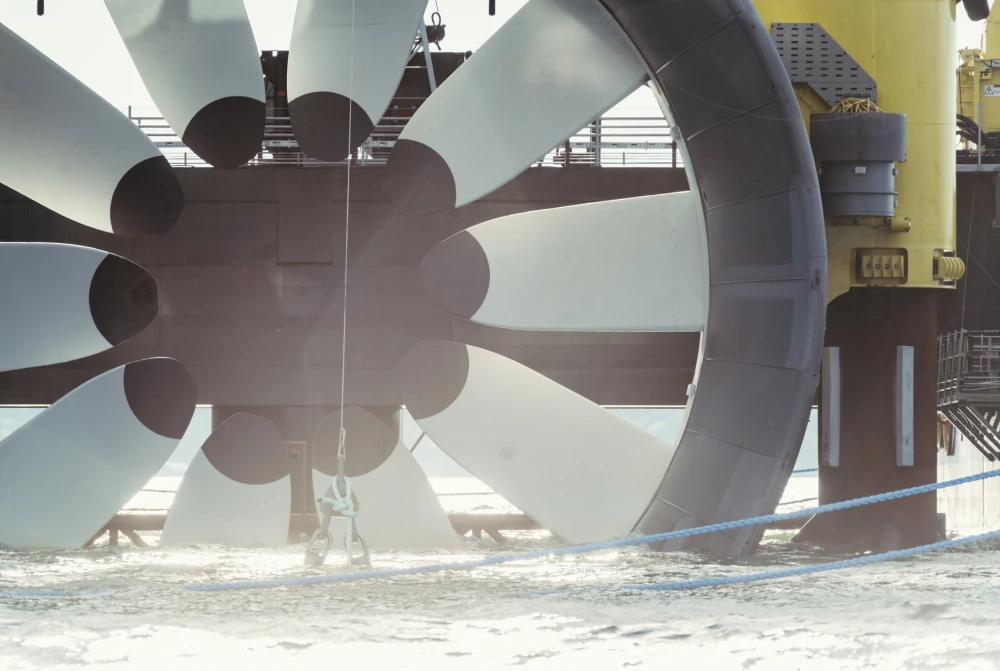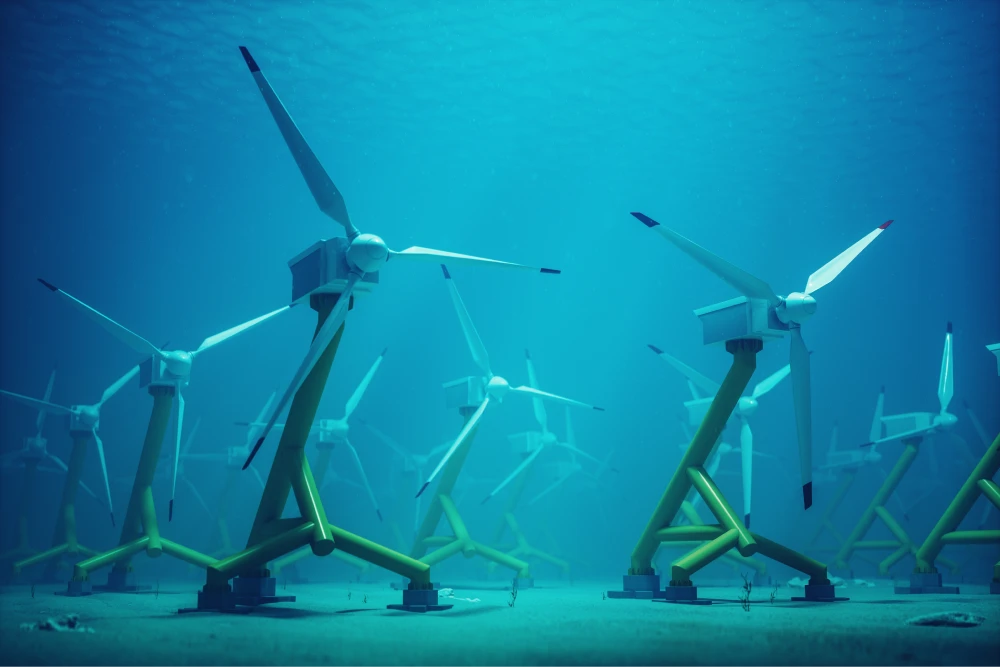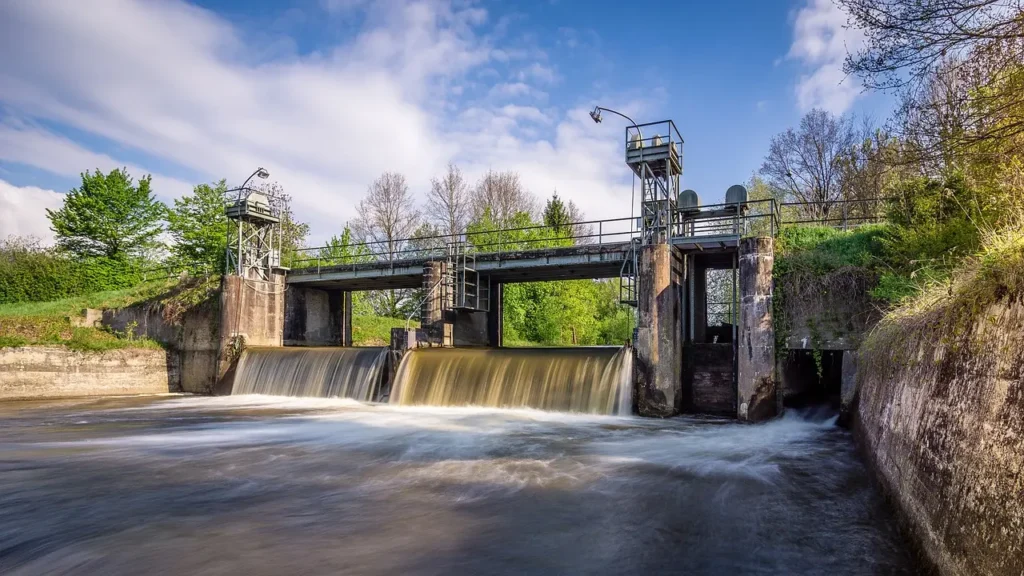Environmental Impact of Hydropower
3 minute readHydropower offers clean electricity but also alters ecosystems, water quality, and greenhouse gas levels.
Home > Learning Center > Energy Production > What Is Tidal Energy?
5 minute read • Last update March 2024

Tidal energy is harnessed from the movement of ocean tides. But how is tidal energy produced, and what are the benefits compared to other well-known energy sources? In this quick guide, we’ll provide a comprehensive tidal energy definition, run through all the pros and cons, and explain why it holds promise as a clean energy alternative.
Tidal energy refers to the practice of generating electricity by utilizing the natural rise and fall of the ocean’s tidal cycle. Captured through various technologies such as tidal barrages, tidal stream generators, and tidal turbines, power output is achieved by converting the kinetic energy of tidal currents into usable electricity.
While tidal power and wave power are both types of hydroelectric energy, the method of electricity generation is different:
Yes, tidal energy is a type of renewable energy. Unlike fossil fuels that rely on a finite supply of source material that will deplete over time, tidal streams present a continuous and inexhaustible power supply, making tidal energy generation a sustainable option.
The immense potential of utilizing ocean tides over other energy sources, including other renewable alternatives, lies in the consistency of the way the moon orbits the Earth and the Earth orbits the sun. The Earth rotates through two tidal “bulges” every lunar day, meaning most coastal areas experience two predictable high and low tide periods every 24 hours and 50 minutes. This makes tidal electricity generation much more reliable than wind and solar power, where the abundance of source availability is less predictable.
Employing specialized equipment in areas with a significant tidal range, such as estuaries, bays, and narrow channels, is the most efficient way to generate power. Three primary types of tidal energy systems exist: tidal stream generators, barrages, and lagoons. Let’s take a look at how each one works in more detail.
Tidal generators use turbine technology. Turbines are placed on the sea floor and rotate as the tide flows in and out, just like the wind turbines we see on land. As the turbines turn, the mechanical power drives the generators connected to them, which in turn produce electricity via electromagnetic induction. The electricity is transmitted through underwater cables to a tidal power station, where it undergoes voltage conversion and integrates into the electrical grid.
Tidal barrages are dam-like structures built across estuaries or bays, equipped with sluice gates that open and close to control water flow. The basic principle involves exploiting the difference in water levels between the ocean and barrage enclosure during high and low tides. With each sea level rise that accompanies high tide, water enters the reservoir and the sluice gates are closed. The water is then released back into the ocean through turbines to generate electricity.
Tidal lagoons are similar to tidal barrages in their function and how they create electricity. The critical difference is the construction of circular or semi-circular structures that form a partial enclosure in the ocean (i.e., a lagoon). Though one of the more expensive tidal technologies in terms of setup, there is more flexibility with positioning as a tidal lagoon can be installed along the natural coastline and/or use estuaries with fresh water emptying into them.

While it may sound like an ideal solution, it’s essential to evaluate all aspects of tidal energy, pros and cons alike. Let’s explore a complete list of benefits and limitations in more detail.
Let’s dig into the specific potential of tidal power as a clean and renewable energy source. The primary benefits of tidal energy are as follows:
Tidal power is a finite resource. Regardless of their energy output, tidal power plants will never deplete our tidal energy reserves.
Tides follow a consistent and predictable pattern based on lunar and solar cycles, reducing reliance on unpredictable weather conditions.
Once installed, tidal energy devices are cheaper to maintain and operate than fossil fuel-based power plants, as they require no fuel and have fewer moving parts.
Tidal currents are dense with energy, resulting in a high electricity generation capacity, even from relatively small-scale installations.
Ongoing research and development into the cost-effectiveness and environmental sustainability of tidal technologies enhance its viability as a mainstream energy source.
While there are undoubtedly several positives, it’s essential to consider the potential limitations of using ocean tides to generate power. The most significant drawbacks include:
The initial setup cost of constructing a tidal stream generator, barrage, or lagoons is substantial, requiring significant capital investment.
Tidal power is only viable in areas with strong tidal currents along coastal areas or estuaries. Therefore, it has limited applicability to land-locked regions.
Tidal installations may disrupt marine ecosystems and aquatic species by creating changes in water flow patterns that lead to habitat loss.
Because they’re located in harsh environments, submerged equipment like tidal turbines and underwater cables present logistical challenges in maintenance and repair.
Though still in its infancy, tidal power is emerging as a pivotal player in reducing fossil fuel reliance and mitigating the impacts of climate change. So, what is tidal energy’s potential in the future as we continue to embrace an ever-broader energy mix?
The total amount of energy contained in the world’s tides is 3,000 gigawatts (one GW being 1 billion watts), and it’s estimated between 120 and 400 GW is available for power generation. To put that into perspective, just 1 GW is enough to power 100 million LED light bulbs. However, either a high tidal range or strong current is required to generate electricity effectively, and some scientists believe that rising sea levels may threaten both in the long term.
Continued research and development into all types of tidal electricity generation is essential to ensure longevity. Currently, much focus is on dynamic tidal power (DTP) – a yet untested but promising concept involving the creation of long, dam-like structures perpendicular to the coast. Unlike traditional tidal power systems, DTP wouldn’t rely on the rise and fall of tides. Instead, it would utilize the kinetic energy of tidal currents as they flow through passages within the dam structures.
At BKVE, we believe energy is a source for good, and we’re committed to offering simple, affordable, and straightforward energy plans tailored to your needs and preferences.
Our number one goal is to help Texas homeowners and renters save money on electricity. Enter your zip code to learn more and find the right plan for your household.
Graham Lumley, Digital Marketing Manager at BKV Energy, leads digital and traditional marketing strategies, focusing on educating Texans about the state's deregulated energy market. With over 8 years of marketing experience, he creates content to help consumers understand and save on their energy bills, bringing a fresh and dynamic approach to the industry.

Hydropower offers clean electricity but also alters ecosystems, water quality, and greenhouse gas levels.

Is geothermal energy renewable or nonrenewable? Geothermal energy is renewable energy that utilizes heat from beneath the Earth’s surface. Heat is produced continuously inside the Earth and can be harnessed for electricity generation and indoor heating. Because the processes beneath the surface of the Earth that generate heat are ongoing…
Get $50 off your electric bill!
Use code BKVEJOINUS50
Enter your zip code to shop BKV Energy's affordable, fixed-rate Texas electricity plans. Use the promo code for $50 off your electric bill.